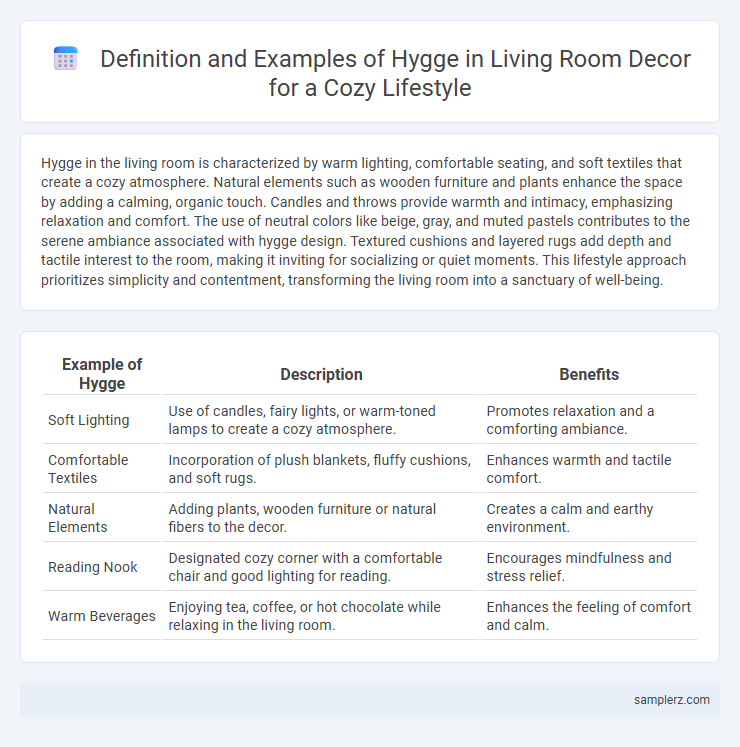Hygge in the living room is characterized by warm lighting, comfortable seating, and soft textiles that create a cozy atmosphere. Natural elements such as wooden furniture and plants enhance the space by adding a calming, organic touch. Candles and throws provide warmth and intimacy, emphasizing relaxation and comfort. The use of neutral colors like beige, gray, and muted pastels contributes to the serene ambiance associated with hygge design. Textured cushions and layered rugs add depth and tactile interest to the room, making it inviting for socializing or quiet moments. This lifestyle approach prioritizes simplicity and contentment, transforming the living room into a sanctuary of well-being.
Table of Comparison
| Example of Hygge | Description | Benefits |
|---|---|---|
| Soft Lighting | Use of candles, fairy lights, or warm-toned lamps to create a cozy atmosphere. | Promotes relaxation and a comforting ambiance. |
| Comfortable Textiles | Incorporation of plush blankets, fluffy cushions, and soft rugs. | Enhances warmth and tactile comfort. |
| Natural Elements | Adding plants, wooden furniture or natural fibers to the decor. | Creates a calm and earthy environment. |
| Reading Nook | Designated cozy corner with a comfortable chair and good lighting for reading. | Encourages mindfulness and stress relief. |
| Warm Beverages | Enjoying tea, coffee, or hot chocolate while relaxing in the living room. | Enhances the feeling of comfort and calm. |
Cozy Textiles: Incorporating Soft Blankets and Cushions
Cozy textiles in a living room, such as soft blankets and cushions, create a warm and inviting atmosphere essential for hygge living. Using materials like chunky knit throws and velvet cushions enhances tactile comfort while adding visual warmth. These elements transform the space into a relaxing retreat, encouraging moments of calm and contentment.
Warm Lighting: Using Candles and Lamps for Ambiance
Warm lighting plays a crucial role in creating a hygge-inspired living room ambiance by utilizing candles and soft lamps that emit a gentle, flickering glow. Strategic placement of beeswax candles or lantern-style lamps enhances cozy textures like wool throws and plush cushions, fostering a sense of comfort and relaxation. This combination of natural light sources and inviting decor transforms the space into a serene retreat ideal for unwinding and intimate gatherings.
Inviting Seating Arrangements for Togetherness
Creating inviting seating arrangements in a living room exemplifies hygge by fostering warmth and togetherness through cozy, plush sofas and armchairs arranged in close proximity. Soft throws, warm cushions, and ambient lighting enhance comfort, encouraging intimate conversations and shared moments. Natural materials like wood and wool contribute to a soothing environment that promotes relaxation and a sense of community.
Natural Elements: Wood, Plants, and Earthy Decor
Incorporating natural elements like wooden furniture, lush green plants, and earthy decor such as clay pots creates a warm and inviting living room atmosphere that embodies hygge. Soft, tactile textures like wool throws and linen cushions enhance comfort while maintaining a connection to nature. These organic materials foster relaxation and well-being by promoting a calm, grounded environment.
Personal Touches: Displaying Meaningful Objects
Personal touches in a hygge living room center around displaying meaningful objects such as family photos, cherished souvenirs, and handcrafted items that evoke warmth and nostalgia. These elements create an intimate atmosphere by connecting the space to personal memories and stories. Incorporating soft textiles like knitted blankets and candles alongside these objects enhances the cozy, inviting ambiance typical of hygge.
Neutral and Warm Color Palettes in Living Spaces
Neutral and warm color palettes create a cozy and inviting living room atmosphere, essential to the hygge lifestyle. Soft beige, creamy whites, and gentle taupes provide a calming backdrop, while warm tones like burnt orange, terracotta, and muted gold add comforting warmth. Layering these colors with natural textures such as wool throws and wooden furniture enhances the serene and snug ambiance typical of hygge-inspired living spaces.
Creating a Reading Nook for Relaxation
A cozy reading nook in a living room embodies hygge by combining soft lighting, plush cushions, and a warm throw blanket to create an inviting space for relaxation. Incorporating natural elements like wooden shelves filled with books and potted plants enhances the calming atmosphere. This intentional setup encourages mindfulness and comfort, perfect for unwinding with a favorite book.
Layering Rugs for Comfort and Style
Layering rugs in the living room enhances hygge by creating a cozy and inviting atmosphere through tactile warmth and varied textures. Combining a soft wool rug with a natural jute or patterned cotton rug adds depth and style while maintaining comfort underfoot. This practice not only boosts insulation but also personalizes the space, aligning with the Scandinavian concept of comfort and simplicity.
Minimalistic Yet Functional Furniture Choices
In a hygge-inspired living room, minimalistic yet functional furniture choices emphasize comfort and simplicity, such as a sleek wooden coffee table paired with a plush, neutral-toned sofa. Incorporating multi-purpose pieces like storage ottomans reduces clutter while enhancing coziness, reflecting the core Danish concept of hygge. Soft textiles and warm lighting complement these elements, creating an inviting, serene atmosphere ideal for relaxation.
Scented Accents: Diffusers and Candles for a Calm Atmosphere
Scented accents like essential oil diffusers and soy candles enhance a living room's hygge ambiance by infusing the space with calming aromas such as lavender, vanilla, or cedarwood. These elements create a warm, inviting atmosphere that promotes relaxation and mindfulness. Incorporating natural scents complements cozy textures and soft lighting, making every moment at home feel serene and comforting.

example of hygge in living room Infographic
 samplerz.com
samplerz.com